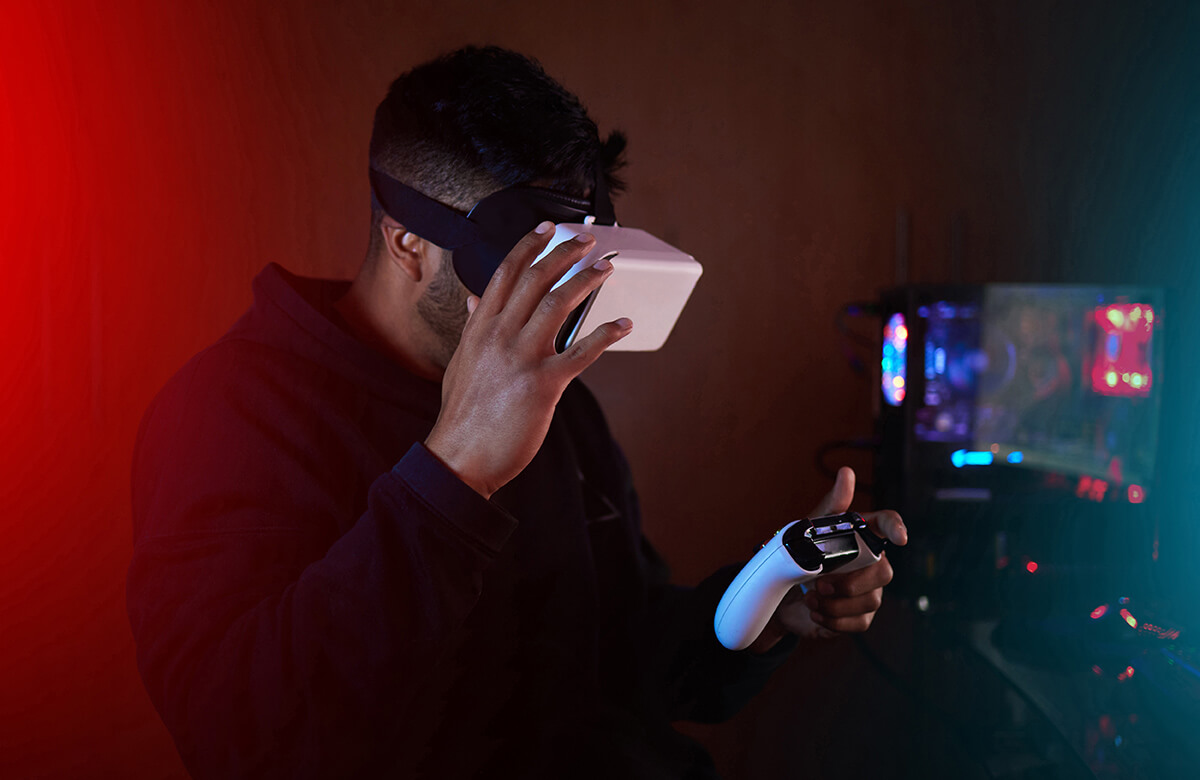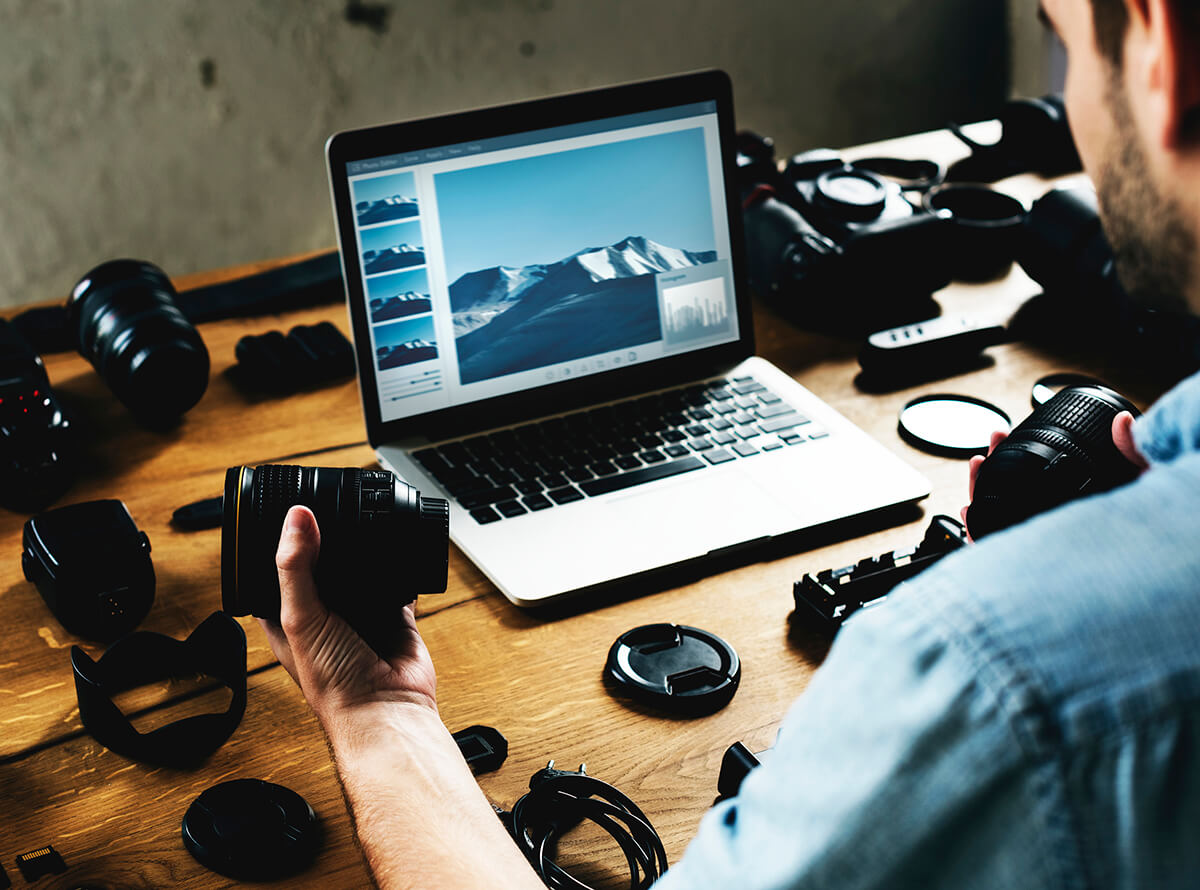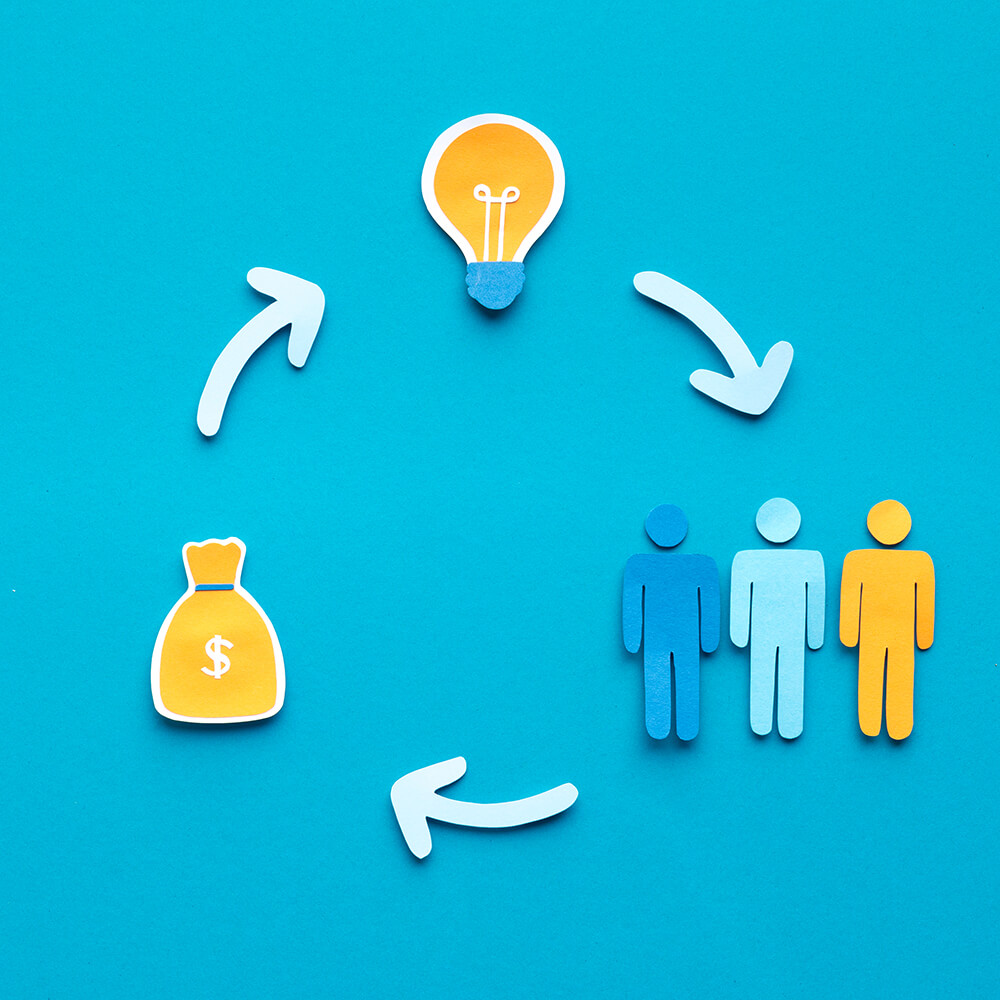Virtual Reality refers to a simulated experience that can be similar to or completely different from the real world. VR technology typically involves wearing a head-mounted display that immerses users in a computer-generated environment, often accompanied by motion tracking and interactive controllers. VR technology has made significant strides in recent years, with improved graphics, increased affordability, and a broader range of content. This has led to a surge in popularity and adoption of VR across various sectors, including gaming, entertainment, education, and training. One new notable headset is the Meta Quest 3 by Meta Augmented Reality overlays digital content onto the real world, enhancing users’ perception and interaction with their environment. AR experiences are typically accessed through mobile devices or smart glasses, allowing users to see and interact with virtual objects in real-time. AR has found applications in fields such as advertising, retail, healthcare, and tourism. For instance, AR allows customers to try on virtual clothing or visualize furniture in their homes before making a purchase. What is Mixed Reality? Most recently, Apple released their Vision Pro which is ‘Mixed Reality’, or a combination of both VR and AR. Apple’s Vision Pro mixed reality headset presents exciting opportunities for sponsorships and content creators. With its ability to transform any room into a personal theater and provide stunning visuals, content creators can deliver immersive and engaging experiences to their audiences. The 3D camera feature allows creators to capture spatial photos and videos, offering a new level of storytelling and enhancing the sponsored content they produce. The collaborative capabilities, such as life-size FaceTime calls and app-based collaboration, enable content creators to connect and collaborate with sponsors and colleagues in a more immersive and interactive way. Additionally, the visionOS spatial operating system empowers creators to develop innovative apps that fill the space around users, providing unique sponsorship opportunities that extend beyond traditional screens. The customizable environments and EyeSight feature also enhance brand integration possibilities, allowing sponsors to create branded virtual landscapes and ensuring that content creators remain connected with their audience while using the headset. The Vision Pro headset may open up new avenues for sponsorships and will enable content creators to deliver captivating and immersive sponsored content experiences to their viewers. The potential of VR and AR as platforms for content creation and consumption VR and AR offer unprecedented opportunities for content creators to craft immersive and interactive experiences. Users can engage with content on a more personal and engaging level, enabling new forms of storytelling, gaming, and education. Content creators in VR and AR must adapt their storytelling techniques to leverage the immersive nature of these technologies. They face challenges such as developing engaging narratives, designing intuitive interactions, and ensuring compatibility with various VR and AR platforms. Sponsorships involve brands collaborating with content creators to promote their products or services. In the digital landscape, sponsorships provide a means for brands to reach targeted audiences through authentic and engaging content. Sponsorships offer content creators financial support and resources to create high-quality content. Brands benefit from increased brand visibility, access to the creator’s dedicated fan base, and the opportunity to align their products or services with relevant content. VR and AR provide a unique canvas for brands to create memorable and interactive experiences that seamlessly integrate their products or services. Monetization Models for VR and AR Content Creators Creating premium content and offering subscription-based access: Content creators in the VR and AR space can cater to their dedicated audience by creating premium content and offering subscription-based access. This model allows creators to offer exclusive and high-quality experiences that are only available to subscribers. By providing access to a range of immersive experiences, such as advanced levels, special events, or unique storylines, content creators can offer added value to their most loyal fans. Subscribers gain the benefit of experiencing content that goes beyond what is available to the general public, creating a sense of exclusivity and reward for their support. Building communities and offering additional perks to subscribers: Subscription-based models not only provide access to premium content but also allow content creators to build communities and offer additional perks to subscribers. These perks can include early access to new releases or updates, behind-the-scenes content that provides insights into the creative process, or exclusive merchandise tied to the VR or AR experience. By offering these additional benefits, content creators can foster a sense of belonging and engagement within their subscriber community. Subscribers feel a closer connection to the creator and fellow subscribers, creating a space for interaction, discussions, and shared experiences. This sense of community can be further strengthened through exclusive events, Q&A sessions, or even virtual meet-ups, where subscribers can directly engage with the content creator and each other. Subscription-based models provide content creators with a more sustainable and consistent revenue stream compared to one-time purchases or ad-based models. They allow creators to focus on creating high-quality content without being solely dependent on sponsorships or ad revenue. By offering premium content and additional perks to subscribers, content creators can reward their most dedicated fans and cultivate a loyal and supportive community. Subscribers, in turn, receive enhanced access and benefits, along with the satisfaction of directly supporting the creators they admire. The subscription-based model not only offers financial stability but also promotes a sense of belonging, exclusivity, and shared experiences. It allows content creators to continuously innovate and produce captivating VR and AR content, knowing they have a dedicated audience willing to support their creative endeavors. The subscription model encourages ongoing engagement and relationship-building between creators and subscribers, fostering a mutually beneficial connection that drives the growth and sustainability of the VR and AR ecosystem. In-App Purchases and Microtransactions Integrating virtual goods and in-app purchases within VR and AR experiences: Content creators have the opportunity to monetize their creations by integrating virtual goods and in-app purchases within VR and AR experiences. These virtual goods can include items such as digital accessories, clothing, furniture, or even virtual currency that users can acquire and use within
Photography is not only an art form but also a profession that offers endless possibilities for creative expression. In addition to capturing memorable moments and stunning visuals, photographers can leverage brand sponsorships and sponsored content creation to create additional income streams. In this blog post, we will explore how different niche photographers, including wedding photographers, lifestyle/family photographers, product photographers, fashion photographers, and portrait photographers, can tap into the power of brand partnerships and monetize their passion. Photography Content Niches Wedding Photographers: Wedding photographers can forge partnerships with brands that cater to engaged couples and the wedding industry. Collaborating with wedding dress designers, bridal boutiques, wedding planners, florists, jewelry designers, and other vendors allows photographers to create sponsored content that features their work alongside these brands. By showcasing their skills and incorporating sponsored products and services, wedding photographers can not only enhance their portfolios but also earn additional income. Lifestyle/Family Photographers: Lifestyle and family photographers have the opportunity to collaborate with brands that cater to families, parenting, and everyday living. From children’s clothing brands and toy companies to home decor and lifestyle products, photographers can integrate sponsored items into their photo shoots, offering authentic and relatable content for their audience. Additionally, partnering with family-focused publications, blogs, or social media accounts can open doors to sponsored campaigns and collaborations. Product Photographers: Product photographers can form partnerships with brands that require high-quality images of their products for marketing purposes. E-commerce businesses, small brands, and startups often seek professional product photographers to capture visually appealing images that highlight the features and qualities of their products. By showcasing these brands’ products in their portfolios and collaborating on sponsored content creation, product photographers can establish themselves as experts in their field while generating additional income. Fashion Photographers: Fashion photographers can collaborate with fashion brands, designers, stylists, and fashion publications to create captivating visual content. From editorial shoots to brand campaigns and lookbooks, fashion photographers can showcase their skills and elevate their portfolios by incorporating sponsored garments, accessories, and beauty products. Collaborating with fashion influencers or bloggers can also lead to sponsored content opportunities that amplify the reach of their work. Portrait Photographers: Portrait photographers have the opportunity to partner with a wide range of brands, depending on their specific niche. For example, fitness portrait photographers can collaborate with athleisure brands, fitness equipment companies, or gyms to capture dynamic images that showcase the brand’s products or services. Similarly, beauty and wellness portrait photographers can collaborate with skincare brands, makeup artists, and wellness retreats to create visually stunning content that promotes these brands. How Brands can Sponsor Photographers In the dynamic world of photography, brands play a significant role in empowering photographers to unleash their creativity. These brands provide cutting-edge software or hardware solutions and seek meaningful collaborations with photographers to showcase their products, educate the community, and foster innovation. Pre-launch Campaigns: When brands are preparing to release, for example, a new camera model, they often collaborate with renowned photographers to build anticipation and generate excitement. These partnerships involve exclusive access to the camera, allowing photographers to test and create content with the upcoming product. By sharing their experiences and insights through blog posts, social media content, and behind-the-scenes videos, photographers can create buzz around the new camera and generate interest among their followers. Sponsored Content Creation: Once the new camera is launched, brands can engage photographers in sponsored content creation. This collaboration involves photographers using the latest camera in their professional work, capturing stunning images that highlight the camera’s capabilities and features. These images can be shared on social media, photography platforms, and brand websites, showcasing the real-world applications of the camera and inspiring other photographers to explore its potential. Reviews and Tutorials: Brands often collaborate with photographers to create in-depth reviews and tutorials of new camera models. These collaborations can take the form of blog posts, YouTube videos, or live webinars, where photographers share their hands-on experiences, discuss the camera’s performance, and provide tips for maximizing its potential. By partnering with photographers who have a strong online presence and expertise in their niche, brands can leverage their credibility and reach to educate and engage a wider audience. Post-Processing Software Tutorials: Brands can collaborate with photographers to create educational content centered around post-processing software. These partnerships can involve creating tutorial videos, online courses, or live workshops where photographers demonstrate editing techniques, share tips and tricks, and showcase the capabilities of the software. By aligning with experienced photographers who are skilled in post-processing, brands can provide valuable learning resources that enhance the skills of photography enthusiasts and promote the usage of their software products. Product Integration: When software brands introduce new features or updates, they can collaborate with photographers to showcase the practical applications of these advancements. Photographers can create before-and-after examples, case studies, or project walkthroughs, highlighting how the latest software capabilities enhance their workflow, improve image quality, or enable creative experimentation. These collaborations not only educate the photography community but also demonstrate the continuous innovation and value offered by the software solutions. Community Engagement: Brands can engage photographers in community-driven initiatives, such as photo contests, challenges, or ambassador programs. By partnering with photographers to promote these activities, brands encourage user participation and create a sense of community among photographers who use their software and hardware. This fosters a vibrant ecosystem where photographers can connect, learn from one another, and showcase their skills, while brands strengthen their relationships with their user base. Brands that sponsor photographer content creators Camera Gear Brands: Camera gear brands understand the value of partnering with photographers to showcase their products and build brand awareness. These collaborations often involve providing photographers with the latest camera bodies, lenses, and accessories to capture stunning images. For example: Canon: As one of the leading camera manufacturers, Canon collaborates with photographers to promote their new camera releases. By providing photographers with early access to their latest models, Canon gains exposure through the photographers’ work and valuable feedback. Nikon: Nikon sponsors photographers to showcase the capabilities of
User-generated content (UGC) has revolutionized the way creators engage with their audience and monetize their influence. In this digital era, creators are leveraging UGC sponsorship deals as a strategic approach to generate recurring revenue. By collaborating with brands to incorporate UGC into their sponsorship agreements, creators can create authentic, compelling content while building long-term partnerships. In this blog post, we’ll explore the concept of UGC, its benefits for creators, and practical tips on how to leverage UGC sponsorship deals for sustainable recurring revenue. Understanding User-Generated Content User-generated content refers to any form of content created by individuals rather than brands themselves. It encompasses a wide range of media, including images, videos, reviews, testimonials, social media posts, and more. UGC allows creators to tap into the creativity and authenticity of their audience, fostering a sense of community and building trust. The Power of UGC Sponsorship Deals: Enhanced Authenticity: UGC sponsorship deals provide creators with the opportunity to align their content with brands in an authentic way. By integrating sponsored products or services into their UGC, creators can maintain their unique voice and style while engaging their audience. Long-Term Partnerships: UGC sponsorship deals often pave the way for long-term partnerships between creators and brands. By consistently producing high-quality UGC that showcases the brand’s offerings, creators can build trust and establish themselves as reliable ambassadors, leading to recurring sponsorship opportunities. Diversified Revenue Streams: UGC sponsorship deals offer creators a diversified approach to revenue generation. Instead of relying solely on traditional ad placements or one-off collaborations, creators can create a steady stream of income by incorporating sponsored UGC into their content strategy. Leveraging UGC Sponsorship Deals for Recurring Revenue Identifying the Right Brands: It’s crucial for creators to align themselves with brands that resonate with their audience and fit their niche. Seek out brands that share similar values and have a genuine interest in collaborating on UGC sponsorship deals. Crafting Compelling UGC: The key to successful UGC sponsorship deals lies in creating engaging and authentic content. Develop creative ideas and formats that seamlessly integrate sponsored products or services into your content while maintaining the trust of your audience. Establishing Clear Sponsorship Guidelines: When entering into UGC sponsorship deals, establish clear guidelines with the brand to ensure both parties are aligned on the content expectations, deliverables, timelines, and compensation. This helps create a mutually beneficial partnership and minimizes misunderstandings. Building and Nurturing Relationships: UGC sponsorship deals often go beyond one-off collaborations. Foster strong relationships with brands by delivering exceptional content, engaging with their marketing teams, and providing valuable feedback. Building these relationships can lead to recurring sponsorship opportunities and mutual growth. Promoting UGC on Multiple Channels: Maximize the impact of UGC sponsorship deals by promoting the content across various platforms and channels. Share it on social media, feature it on your website or blog, and consider leveraging email marketing to reach a wider audience. Measuring and Showcasing Results: To demonstrate the effectiveness of UGC sponsorship deals, utilize analytics tools to track engagement, reach, and conversions. Share these insights with brands to showcase the value of the partnership and negotiate future recurring sponsorship opportunities. The Rise of Short-Form UGC Short-form UGC has experienced exponential growth in recent years, with platforms like TikTok and Instagram Reels leading the way. These platforms have become hubs for creativity, allowing users to create and share short videos that entertain, educate, and inspire. TikTok, in particular, has become a global sensation, boasting over a billion active users worldwide. TikTok’s algorithm-driven feed and viral nature make it an ideal platform for creators to gain visibility and build a dedicated following. By consistently creating engaging and authentic content, creators can amass a large audience, which in turn attracts the attention of brands looking for promotional opportunities. Here’s how creators can leverage TikTok for sponsorship deals: Showcasing Products: Creators can integrate sponsored products seamlessly into their TikTok videos, demonstrating their features, benefits, and unique use cases. By presenting products in a creative and entertaining way, creators can capture their audience’s attention and generate interest in the brand. Participating in Challenges: TikTok challenges are a popular feature that encourages users to create videos based on a specific theme or concept. Creators can collaborate with brands to launch sponsored challenges, amplifying brand visibility and engaging with their audience on a deeper level. Influencer Campaigns: Brands often partner with influential TikTok creators to promote their products or services. Creators can negotiate sponsored content deals where they create dedicated videos showcasing the brand and its offerings to their followers. Instagram Reels for Sponsorship Opportunities:Instagram Reels, a short-form video feature within the Instagram platform, offers similar opportunities for creators to leverage UGC for sponsorship deals. With its user-friendly interface and expansive user base, Reels can be a powerful tool for creators to monetize their content. Here are some strategies for creators looking to attract brand sponsorships on Instagram Reels: Product Demonstrations: Creators can create Reels that feature sponsored products and provide informative and engaging demonstrations. By showcasing the products in action and highlighting their unique features, creators can create authentic and relatable content that resonates with their audience. Storytelling and Narrative-based Content: Brands are often looking to align their messaging with compelling stories. Creators can leverage Reels to tell captivating stories that incorporate sponsored products or brand messages, creating a seamless integration between the content and the sponsor. Collaborations and Influencer Takeovers: Collaborating with other creators or taking over a brand’s Instagram account for a day can be an effective way to showcase sponsored content to a wider audience. These collaborations allow for cross-promotion and can drive significant engagement and visibility for both the creator and the brand. Creating Recurring Revenue Streams One of the key advantages of UGC sponsorships is the potential for recurring revenue. By consistently creating valuable and engaging content, creators can establish themselves as trusted influencers and attract long-term sponsorship deals. Here are some strategies to create recurring revenue streams: Building Long-term Partnerships: Cultivating strong relationships with brands can lead to ongoing sponsorship opportunities.
Brand deals and sponsorships have become an increasingly popular way for companies to reach their target audience. From athletes to social media influencers, newsletters to podcasts, brands are constantly looking for new and innovative ways to promote their products and services. In this post, we’ll take a closer look at how brand deals and sponsorships work, and how creators can protect themselves while conducting these deals. Athlete Sponsorships Athlete sponsorships are a form of brand deal where companies pay athletes to use and promote their products. These sponsorships are particularly popular in sports where athletes have a large following, such as basketball, football, and soccer. The athlete may wear the company’s logo on their clothing or equipment, or they may create content promoting the product on their social media channels. Action sports have long been a popular platform for brands to promote their products and services, and many athletes in these sports have secured lucrative sponsorship deals. Here are some examples of successful action sport sponsorships: Red Bull and Freestyle Motocross: Red Bull has been a major sponsor of Freestyle Motocross for many years, hosting events such as the Red Bull X-Fighters and sponsoring top riders like Travis Pastrana and Josh Sheehan. The energy drink company has created a strong connection with the sport and its audience, providing exposure and financial support to the athletes. Burton Snowboards and Professional Snowboarders: Burton Snowboards is one of the most well-known brands in snowboarding, and has sponsored some of the top riders in the sport such as Shaun White, Terje Haakonsen, and Mark McMorris. In addition to providing equipment, Burton has also collaborated with these riders on signature lines and events, further solidifying their relationship. Nike and Skateboarding: Nike has made a significant investment in the skateboarding industry in recent years, sponsoring top skateboarders such as Paul Rodriguez and Eric Koston, and even creating its own skateboarding division. Through its sponsorship deals, Nike has been able to expand its reach into the skateboarding community and establish itself as a major player in the industry. Monster Energy and BMX: Monster Energy has been a major sponsor of BMX events and athletes, sponsoring the annual Monster Energy BMX Triple Challenge and top riders such as Pat Casey and Kevin Peraza. The energy drink company has used its sponsorship deals to gain exposure in the BMX community and connect with fans of the sport. When it comes to action sports sponsorships, it’s important for both brands and athletes to carefully consider their partnerships. Brands should choose athletes that align with their values and target audience, while athletes should only accept sponsorships from brands they believe in and trust. It’s also important for both parties to have clear expectations and communication throughout the sponsorship process, including details on compensation, deliverables, and timelines. For athletes, sponsorships can be a lucrative source of income. However, it’s important for athletes to be selective about the brands they partner with. They should only work with brands that align with their values and image, and they should ensure that the terms of the sponsorship are fair and reasonable. Newsletter Sponsorships Newsletter sponsorships are a form of brand deal where companies pay newsletter creators to promote their products or services in their newsletter. Newsletters have become an increasingly popular way for companies to reach their target audience as they provide a direct line of communication with subscribers. For newsletter creators, sponsorships can be a great way to monetize their content. However, they should ensure that the products or services they promote align with their brand and that they disclose any sponsored content to their subscribers. This can help to build trust with their audience and ensure that their readers are aware of any potential conflicts of interest. The Morning Brew, a daily business newsletter, has over 4 million subscribers and is known for its witty, conversational tone. The newsletter includes a section called “Top News” where readers can catch up on the latest business news, and it also includes a section called “Latest from The Brew” where the newsletter promotes its own content, such as its podcast or paid subscription service. The Hustle, a daily tech and business newsletter, has over 2 million subscribers and is known for its engaging content and quirky brand personality. The newsletter includes sections such as “The Hustle Standard” where it highlights a successful entrepreneur, and “Sh*t to Know” where it provides quick and informative snippets of news. Both of these newsletters have successfully integrated sponsored content into their newsletters without disrupting the reader’s experience. For example, The Morning Brew has featured sponsored content from companies such as Mastercard, Citi, and Betterment, while The Hustle has worked with companies such as Microsoft, IBM, and Nike. In terms of industries that have successfully utilized newsletter sponsorships, the tech and business sectors have been particularly successful. Companies in these industries are often looking to reach a specific audience of entrepreneurs, business professionals, and investors, and newsletters offer a targeted and engaged audience. However, newsletters can be effective in a variety of industries. For example, food and lifestyle newsletters can be a great way for brands in the food and beverage industry to promote their products to a receptive audience. Newsletters focused on travel and leisure can be a valuable platform for hotels and resorts looking to promote their properties. For creators looking to secure newsletter sponsorships, it’s important to create a newsletter with a clear and consistent brand identity. By building a loyal subscriber base and establishing a strong brand identity, creators can attract brands that align with their niche and audience. Creators should also be transparent with their subscribers when featuring sponsored content. By clearly labeling sponsored content and ensuring it aligns with the brand’s values and message, creators can maintain their credibility with their subscribers. In terms of pricing for newsletter sponsorships, creators can charge based on the number of subscribers or the reach of the newsletter. Some creators may also charge a flat rate per sponsored
In the age of social media, influencers have become a vital part of a brand’s marketing strategy. With the rise of Instagram, TikTok, and YouTube, influencer marketing has become an essential way for brands to connect with their target audience. However, for small influencers, finding and securing brand deals can be challenging. In this post, we’ll break down how to find and secure brand deals for small influencers based on their follower count. Under 1000 Followers For creators just starting out, it can be difficult to secure brand deals as they don’t have a significant following. However, there are still a few ways to find brand deals. Be Active on Social Media To increase your chances of getting noticed by brands, you need to be active on social media. Post frequently, engage with your followers, and use relevant hashtags. You can also reach out to other small influencers and collaborate with them on projects. By building a community of like-minded creators, you can increase your visibility and reach. Utilize Hashtags and Geo-Tags Hashtags and geo-tags are crucial for increasing your visibility on social media. Use relevant hashtags to make your posts more discoverable, and geo-tags to target a specific audience. By using these tools, you can increase your chances of getting noticed by brands. Reach Out to Small Brands Small brands are always on the lookout for new and upcoming influencers to work with. Reach out to small brands in your niche and pitch yourself as an influencer who can help them reach their target audience. You can also offer to create content for them in exchange for free products or a small fee. Some other tips for small influencers just starting out with under 1000 followers are: Create Quality Content: One of the most important things to focus on as a small influencer is creating quality content. Brands want to work with influencers who have a unique style and can produce high-quality content. Experiment with different types of content and find what works best for your niche. By consistently producing great content, you’ll increase your chances of getting noticed by brands. Engage with Your Followers: Engaging with your followers is essential for growing your audience and attracting brand deals. Respond to comments and messages, and take the time to build relationships with your followers. By showing your audience that you care about them, you’ll build a loyal following that brands will want to tap into. Network with Other Influencers: Networking with other influencers can also help you land brand deals. Attend influencer events and connect with others in your niche. By building relationships with other influencers, you can collaborate on projects and increase your visibility. You can also cross-promote each other’s content to reach a wider audience. Take Advantage of Influencer Marketplaces: There are also influencer marketplaces that can help you find brand deals as a small influencer. Platforms like Sponsora and others allow you to create a profile and connect with brands looking for influencers. These platforms are great for getting started and can help you build relationships with brands. Sponsora is one of the only few that accept creators of all sizes. Get started for free! In terms of earning potential, small influencers may not make as much as larger influencers, but they can still earn money through brand deals. Some brands may be willing to work with smaller influencers for a lower fee or in exchange for free products. As you grow your following and increase your visibility, you can start to command higher rates. 1k-5k Followers Once you’ve built a following of 1k-5k followers, you can start to secure brand deals. Here are a few ways to do so: Create a Media Kit A media kit is a great way to showcase your work and attract potential brand partners. It should include your bio, social media handles, statistics on your reach and engagement, and examples of your work. A media kit can make it easier for brands to evaluate your content and decide whether you’re a good fit for their brand. Use Influencer Marketing Platforms Influencer marketing platforms like Sponsora can connect you with brands looking for influencers in your niche. Our platform provide a marketplace where brands and influencers can find each other, negotiate rates, and collaborate on campaigns. Attend Industry Events Attending industry events, such as conferences and trade shows, can help you network with brands and other influencers. These events provide a great opportunity to learn more about the industry and to meet potential brand partners. 10k-100k Followers For influencers with 10k-100k followers, brand deals become more common. Here are a few ways to secure brand deals at this stage: Build Relationships with Brands As you gain more followers, it’s essential to start building relationships with brands. Reach out to brands you love and create content for them in exchange for a fee or free products. By building relationships with brands, you can secure long-term partnerships and increase your earning potential. Pitch Yourself to Brands If you’re interested in working with a specific brand, pitch yourself to them. Send them an email or DM, and showcase your work and why you’d be a good fit for their brand. Make sure to personalize your pitch and show the brand that you’re genuinely interested in working with them. Work with an Agency Working with an agency can help you secure more significant brand deals and simplify the negotiation process. An agency can help you create a media kit, negotiate rates, and manage campaigns. However, keep in mind that agencies often take a significant cut of revenue from your brand deals, and the deals they bring you may not align with your values. 10k-100k followers: Once you’ve reached the 10k-100k follower range, you can start to attract more significant brand deals. This is because you have a solid following that trusts you and your content. At this point, you may also have established yourself as an expert in your niche, which makes you more
Content creation has become a popular and lucrative career path for many aspiring entrepreneurs, influencers, and creators. With the rise of social media platforms and the increasing demand for digital content, there are numerous niches that offer unique opportunities for content creators to thrive. In this post, we will explore the top 5-10 content creation niches, along with information on the highest paying content on youtube based on CPC (cost per click) from YouTube ads. Personal Finance and Investing With the growing interest in financial literacy and investing, personal finance and investing have become a popular content creation niche. Creators in this niche share tips and advice on budgeting, saving, investing, and building wealth. Content can range from educational videos on investment strategies, reviews of financial products, and interviews with financial experts. The CPC for YouTube ads in this niche can be high, ranging from $0.50 to $2.00 or even higher, depending on the target audience and keywords. Technology and Gadgets As technology continues to advance rapidly, the demand for content related to gadgets, tech reviews, and tutorials has also increased. Creators in this niche cover topics such as smartphone reviews, software tutorials, gaming, and emerging technologies. The CPC for YouTube ads in the technology and gadgets niche can vary, but it generally falls in the range of $0.30 to $1.50 or higher, depending on the competition and target audience. Beauty and Fashion The beauty and fashion niche has been a popular content creation niche for years, with creators sharing beauty tips, makeup tutorials, fashion hauls, and style advice. This niche often attracts a large and engaged audience, making it an attractive choice for content creators. The CPC for YouTube ads in the beauty and fashion niche can range from $0.20 to $1.50 or higher, depending on the target audience and keywords. Travel and Adventure Travel and adventure content has become increasingly popular, with creators sharing their experiences, travel tips, and destination reviews. This niche appeals to those who are passionate about exploring new places and seeking unique adventures. The CPC for YouTube ads in the travel and adventure niche can vary widely, depending on the location, keywords, and target audience, but it can range from $0.30 to $2.00 or higher. Health and Fitness The health and fitness niche is another popular content creation niche, with creators sharing workout routines, nutrition tips, and wellness advice. With the increasing interest in fitness and wellness, this niche offers opportunities for creators to share their knowledge and expertise. The CPC for YouTube ads in the health and fitness niche can vary, but it generally falls in the range of $0.30 to $1.50 or higher, depending on the target audience and keywords. Cooking and Food The cooking and food niche has gained popularity in recent years, with creators sharing recipes, cooking tutorials, and food-related content. This niche attracts food enthusiasts and those who enjoy trying new recipes and exploring different cuisines. The CPC for YouTube ads in the cooking and food niche can range from $0.20 to $1.50 or higher, depending on the target audience and keywords. Parenting and Family The parenting and family niche is a popular choice for content creators who share advice, tips, and stories related to parenting, pregnancy, and family life. This niche appeals to parents, caregivers, and those interested in family dynamics and child development. The CPC for YouTube ads in the parenting and family niche can vary, but it generally falls in the range of $0.20 to $1.00 or higher, depending on the target audience and keywords. Home Improvement and DIY As more people are spending time at home and looking for ways to improve their living spaces, the home improvement and DIY niche has gained popularity. Home improvement is one of the only sectors that sees spikes of growth during economic downturns. Creators in this niche share tutorials, tips, and hacks for home improvement projects, interior design, and DIY crafts. The CPC for YouTube ads in the home improvement and DIY niche can vary, but it generally falls in the range of $0.20 to $1.00 or higher, depending on the target audience and keywords. Lifestyle and Vlogging The lifestyle and vlogging niche is a broad category that encompasses a wide range of topics, such as daily vlogs, challenges, lifestyle hacks, and personal stories. Creators in this niche share their daily lives, experiences, and insights with their audience, creating a sense of connection and relatability. The CPC for YouTube ads in the lifestyle and vlogging niche can vary widely depending on the content and target audience, ranging from $0.10 to $1.00 or higher. Business and Entrepreneurship The business and entrepreneurship niche is gaining popularity as more people are interested in starting their own businesses and pursuing entrepreneurship. Creators in this niche share tips, strategies, and advice on various aspects of business, such as marketing, sales, finance, and leadership. The CPC for YouTube ads in the business and entrepreneurship niche can vary, but it generally falls in the range of $0.50 to $2.00 or higher, depending on the target audience and keywords. It’s important to note that the CPC for YouTube ads can fluctuate based on factors such as location, competition, seasonality, and advertisers’ bidding strategies. Additionally, YouTube’s algorithm is constantly evolving, and content creators should focus on creating high-quality, engaging content that resonates with their audience, rather than solely relying on CPC as the sole indicator of success. In conclusion, content creation offers lucrative opportunities in various niches. The highest paying CPC for YouTube ads can vary depending on the niche, target audience, and keywords. If you’re considering starting a content creation channel, it’s important to choose a niche that aligns with your interests, expertise, and audience preferences. By creating valuable and engaging content, building a loyal audience, and staying up-to-date with industry trends, you can maximize your earning potential as a content creator.







